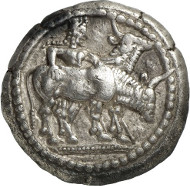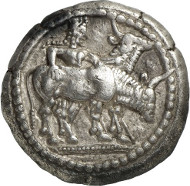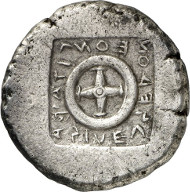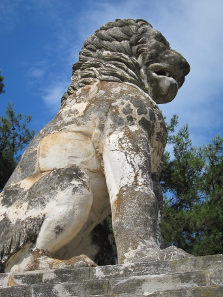A cownapper as royal role model
“Of the gods they worship only Ares and Dionysus and Artemis. Their kings, however, apart from the rest of the people, worship Hermes more than all gods, and swear by him alone; and they say that they are descended from Hermes.” This is how Herodotus describes the customs of the Thracians. Naturally, here we have the typical misunderstanding of a Greek trying to refer to foreign deities by using the names of the gods he worships. The truth of the matter is that things were a bit more complicated:
The main deity of the Thracians was a maternal goddess who manifested herself in the mountains and who was associated by the Greeks with the Great Goddess, hence Artemis. She bore a son, a stone god who threw thunder and lightning and who was to be worshipped later as Sabazios in orgiastic rites. Sabazios had two faces. On the one hand, he was a dark god with a sinister appearance, but on the other hand he granted his followers exemption from any personal guilt. That was perhaps the reason why the Greeks recognized Dionysus in him.
In a sacred wedding, mother and son generated their very first believer, Rhesus, who is likewise referred to as Orpheus of the north. He acted as priest of Dionysus in the Pangaion Hills and was identified with Ares, as we know from Euripides who dedicated a tragedy to him.
Now, the only one still missing is Hermes; Herodotus uses that name to refer to Anax, the first mythical priest of the Thracians, founder of all Thracian royal dynasties, who traced her privilege of being the only initiates into the mystery cult of Sabazios back to him.
This unusually well preserved octodrachm of King Getas, ruler of the Edones, will be auctioned off on 10 March 2014 at Gorny & Mosch. It is estimated at 75,000 euros.
Getas, King of wealthy Edones, traced his roots to Anax-Hermes as well. That was why he chose him as motif for his octodrachms of which Gorny & Mosch are able to present a specimen in an unusually fine condition in the upcoming auction on 10 March 2014. The obverse, showing Anax as Hermes in a completely hellenized appearance, illustrates clearly how well acquainted the Edones had become with Greek philosophy.
According to Greek mythology, Hermes – already on the day of birth – first found the lyre and then quickly stole 50 cattle of Apollo, and that is exactly the subject depicted on the obverse of the octodrachm. Apollo noticed the theft but couldn’t track the thief because Hermes had covered his traces neatly. What he didn’t know was that a shepherd had seen him stealing and informed Apollo about it. The latter turned to the mother of Hermes, Maia, who referred to the peaceable toddler in his cradle. Young Hermes pointed out clearly that by all means he was much too young to commit something like that and that he had yet no knowledge as to what cattle means in the first place. Then Apollo went to Zeus and charged Hermes. By that time, Zeus had already tipped to the scam and condemned Hermes to return the stolen cattle. Hermes, in turn, got the lyre out, played on it and offered the musical instrument to Apollo in exchange for the 50 cattle. Apollo agreed and so peace between the gods was restored.
The most famous sight of today’s Amphipolis is a lion once a Hellenistic funeral monument. Photo: KW.
King Getas, who had this coin minted, was one the most powerful rulers in Macedonia. He was a contemporary – and rival – of Alexander I, King of the Macedons and ruled over a territory with immense natural resources. The center of power was the region at the tailwater of the Strymon River, that was of high strategic importance, where the city of Amphipolis was to be founded – and fiercely fought over – later. Getas controlled both the silver and the gold mines in the Pangaion Hills. The silver yielded there was used to mint the large octrodrachms.
But one question remains: why did the king of the Edones need these coins that weren’t suited for the local retail trade? Many specimens were found at places that were ruled by Persians in the days of Getas. Some scholars take that as evidence for the octodrachm being produced as tribute for the Persian king. After all, Persian troops had tried to gain control of rich northern Greece as early as the turn of the 6th to the 5th century. In 480, they succeeded eventually, when Xerxes forced the Edones to join his army in his fight against Athens. Did the Edones become truly autonomous after the Persian troops left in 476? Did they continue to pay a nominal tribute to the Persian ruler? The sources provide no answer to that.
What we do know, however, is that, after their victory over the Persians, the Athenians tried to gain control over the treasures in the north. The Edones wore themselves out in a fight against the Macedonian king on the one side and the Athenians on the other side. It was in 424 that the last Edonian king lost his life in a battle over future Amphipolis. The Edones disappeared from history. The name Edonis for a region of the Roman province is the only thing that recalls its former prosperity.











